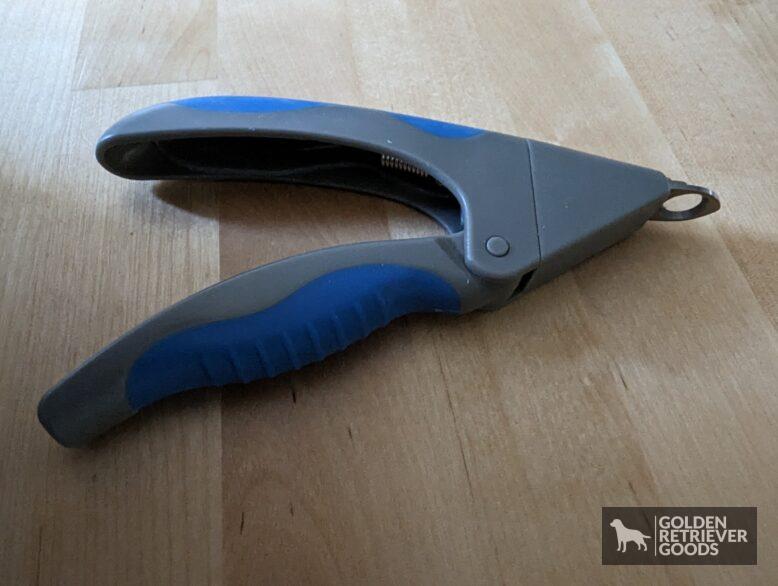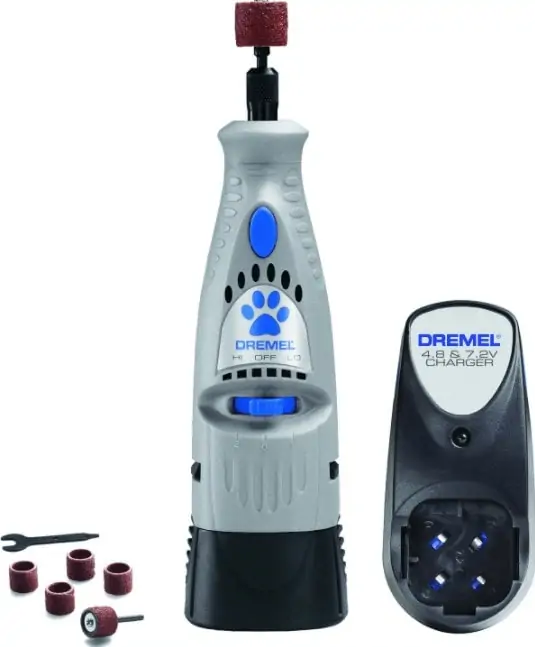How To Trim Golden Retriever Nails
The three most important pieces of advice when learning how to trim Golden Retriever nails are:
1. Use high-quality nail clippers that are designed for dogs
2. Trim a little bit of the nail at a time to avoid cutting the quick (the blood vessel inside the nail). Cut at a 45 degree angle so the cut edge of the nail is parallel to the floor when your dog is standing upright.
3. Reward your dog with treats and praise to create a positive association with nail trimming
Trimming a golden retriever’s nails is the same as trimming any other dog’s nails. Unfortunately, nail trimming is a common point of stress for your dog and is not always as easy as it should be. The video below is an excellent visual reference for trimming your pup’s nails, and below we’ll also outline some quick tips on how to trim a golden retriever’s nails.
How To Cut A Golden Retriever’s Nails

Trimming your Golden Retriever’s nails is a simple process that you can do at home or with the help of a professional groomer. You should trim your dog’s nails every 2-3 weeks to keep them at the ideal length. Be sure to use sharp, high-quality nail clippers that are designed for dogs.
Using dog nail clippers may seem intimidating at first, but with the right technique and tools, it can be a simple and stress-free process. Here are some tips on how to use dog nail clippers effectively and safely.
Choosing the Right Clippers
The first step in using dog nail clippers is choosing the right ones. Look for clippers that are specifically designed for dogs, as human nail clippers may not be strong enough to cut through a dog’s thicker nails.
Guillotine Clippers

Guillotine style dog nail clippers are a type of nail clipper that feature a small hole where you insert your dog’s nail. When you squeeze the handles, a blade slides across the hole and cuts the nail. These clippers are easy to use and provide a clean cut, making them a popular choice for many dog owners. However, they may not be suitable for dogs with very thick nails, and it’s important to choose a high-quality pair to ensure safety and effectiveness.
Scissor Clippers

Scissor style dog nail clippers are a type of nail clipper that resemble scissors. They feature two blades that come together when you squeeze the handles, cutting the nail. These clippers are also fairly easy to use and provide a clean cut, making them a popular choice for many dog owners. They are also suitable for dogs with very thick nails, as they provide more leverage than guillotine-style clippers. It’s important to choose a high-quality pair to ensure safety and effectiveness.
Grinder Trimmers

Grinder trimmer style dog nail clippers are a type of nail trimmer that use a rotating grinder to file down the dog’s nail. These clippers are suitable for dogs with very thick nails or those who are sensitive to the pressure of traditional clippers. They provide a smooth and even trim, reducing the risk of cutting the quick. However, they can be noisy and may take longer to use than traditional clippers. It’s important to choose a high-quality grinder trimmer to ensure safety and effectiveness.
Choose the type that you feel most comfortable using, but usually guillotine-style clippers are the easiest to use overall. Some people prefer the scissor-style clippers specifically for the dog’s dew claw (the “thumb” claw that’s higher than the others on a dog’s front paws).
Grinder or dremel-style trimmers are an excellent choice for some dogs that may have an extreme aversion to cut-style clippers, but can also be even more of an issue for certain dogs due to how much noisier they are than a manual pair of clippers.
Preparing Your Dog
Before you begin trimming your dog’s nails, it’s important to prepare them for the process. Familiarize your dog with the clippers by letting them sniff and investigate them. Use treats and praise to create a positive association with the clippers.
If you have particularly anxious dog, or one that truly does not like his paws being touched, consider reaching out to your vet to see if they’ll do it for you (usually for a small fee), or to discuss medication options for nail clipping. Our golden gets a small dose of trazadone before every clipping session, and it does wonders in allowing us to clip quickly, safely, and effectively without causing her undue stress.
Read more: How To Trim A Golden Retriever’s Paws
Finding the Quick
The quick is the blood vessel inside your dog’s nail, and it’s important to avoid cutting it while trimming their nails. You can identify the quick by looking for the pink or red tissue inside the nail. If your dog has dark nails, it may be harder to see the quick. In this case, trim a little bit of the nail at a time until you see a black dot in the center of the nail. This is the start of the quick, and you should stop trimming at this point.

A dog’s quick will continually grow as the nail does – if your dog has very long nails that have been neglected for some time, you won’t be able to trim them to the correct length immediately. You will need to trim to the quick, then wait a few days for the quick to recede further, then trim again to the quick. You can repeat this process as many times as needed to achieve the correct nail length for your golden retriever.
After the nails are at the correct length, it’s important to stick to a 2-3 week trimming routine in order to avoid the quick growing excessively back out again.
Trimming Your Dog’s Nails
Once you’ve prepared your dog and identified the quick, it’s time to start trimming their nails. Hold your dog’s paw firmly but gently, and use the clippers to cut a small amount of the nail at a time. It’s better to trim too little than too much, as cutting the quick can be painful and cause bleeding. If you do accidentally cut the quick, use styptic powder or cornstarch to stop the bleeding.
Don’t forget to trim your golden’s “thumb,” which is the shorter claw located higher up on your dog’s front paws. Technically this is called the dew claw. The dew claw does not touch the ground so is never naturally worn down while your dog walks and runs. This means it can get longer faster than your dogs other claws, and is at higher risk of growing into your dog’s toe pad and causing pain.
What angle to cut at
You should cut your golden’s nails at a 45 degree angle – not just straight across. The cut edge of the nail should run parallel with the floor to ensure natural movement for your dog’s paws when standing and walking.
Using a Nail File
After trimming your dog’s nails, you can use a nail file or motorized tool to smooth any rough edges. This will help prevent your dog’s nails from snagging on carpets or furniture. You can also use the file to round the edges of the nails, which can help prevent them from curling under the paw.
15 Tips For Cutting Your Golden Retriever’s Nails
- Use high-quality nail clippers designed for dogs.
- Familiarize your Golden Retriever with nail clippers before the first trim.
- Use treats to create a positive association with nail trimming.
- Make sure your dog is calm and relaxed before trimming their nails.
- Use a firm grip to hold your dog’s paw steady.
- Identify the quick (the blood vessel inside the nail) before trimming.
- Trim a little bit of the nail at a time to avoid cutting the quick, cutting at a 45 degree angle.
- Use a nail file to smooth rough edges after trimming.
- Use styptic powder or cornstarch to stop bleeding if you accidentally cut the quick.
- Avoid trimming your dog’s nails too short.
- Trim your dog’s nails every 2-3 weeks.
- Use a well-lit area to avoid accidentally cutting the quick.
- Stay calm and patient during the trimming process. Dogs can sense your emotions, so if you’re anxious or stressed, your dog may become anxious or stressed as well.
- Take breaks if your dog becomes anxious or restless.
- Seek the help of a professional groomer or veterinarian if you’re not comfortable trimming your dog’s nails yourself.
Conclusion
Trimming your golden retriever’s nails can be a simple and stress-free process with the right technique and tools:
- Choose clippers that are specifically designed for dogs
- Prepare your dog for the process
- Identify the quick
- Trim a little bit of the nail at a time, cutting at a 45 degree angle
- Use a nail file to smooth rough edges and round the edges of the nails
- Stay calm and patient, and reward your dog with treats and praise throughout the process.
If you’re not comfortable trimming your dog’s nails yourself, seek the help of a professional groomer or veterinarian
FAQs
Can I use human nail clippers to trim my dog’s nails?
No, human nail clippers are not designed for the thicker, stronger nails of dogs.
How can I tell if I’ve cut the quick?
If you accidentally cut the quick, you’ll see a small amount of bleeding. Apply pressure with a clean cloth or use styptic powder or corn starch to quickly stop the bleeding.
What if my dog hates getting their nails trimmed?
You can try desensitizing your dog to nail trimming by touching their paws and nails regularly and rewarding them with treats and praise. You can also try using a calming aid or seeking the help of a professional trainer or groomer.
Related Reading
- How Long Should A Golden Retriever’s Nails Be?
- How Often Do Golden Retrievers Pee?
- Why Do Golden Retrievers Eat Poop?
- How Often Do Golden Retrievers Poop?
- When Do Golden Retrievers’ Growth Plates Close?
We want to remind our readers that the articles or content found on goldenretrievergoods.com do not constitute nor replace professional veterinary advice, diagnosis, or treatment. The information provided on our website is purely educational and informational, and should not be used as a substitute for advice from a licensed veterinarian.

